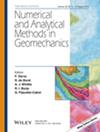Group Effects of Energy Pipe Piles Embedded in Layered Transversely Isotropic Soils Due to Thermo-Mechanical Loading
Abstract
Energy pile technology is an environmentally sustainable and economically viable solution to achieve building thermal comfort. Energy pipe piles offer advantages over solid piles due to their inner hollow space, allowing for the installation of heat exchange tubes and optimization of backfill materials. Although the activation of an energy pile group can significantly promote the heat exchange performance for satisfying the energy demand of upper structures, there is currently no efficient calculation method available for the energy pipe pile group. Hence, this paper utilizes the coupled boundary element-finite element method to investigate behaviors of energy pipe pile groups embedded in layered transversely isotropic soils, aiming to guide optimal design and accelerate application promotion. The proposed method's validity is confirmed through field tests and finite element simulations. Parametric analyses indicate that the reduction of pile thickness weakens the group effect, and the induced tensile forces in pipe piles under cooling conditions should be paid more attention when the pile spacing is large and the soil is stiff. Besides, a stiff bearing stratum minimizes the overall settlement and facilitates the uniform axial force distribution within energy pipe pile groups.

 求助内容:
求助内容: 应助结果提醒方式:
应助结果提醒方式:


